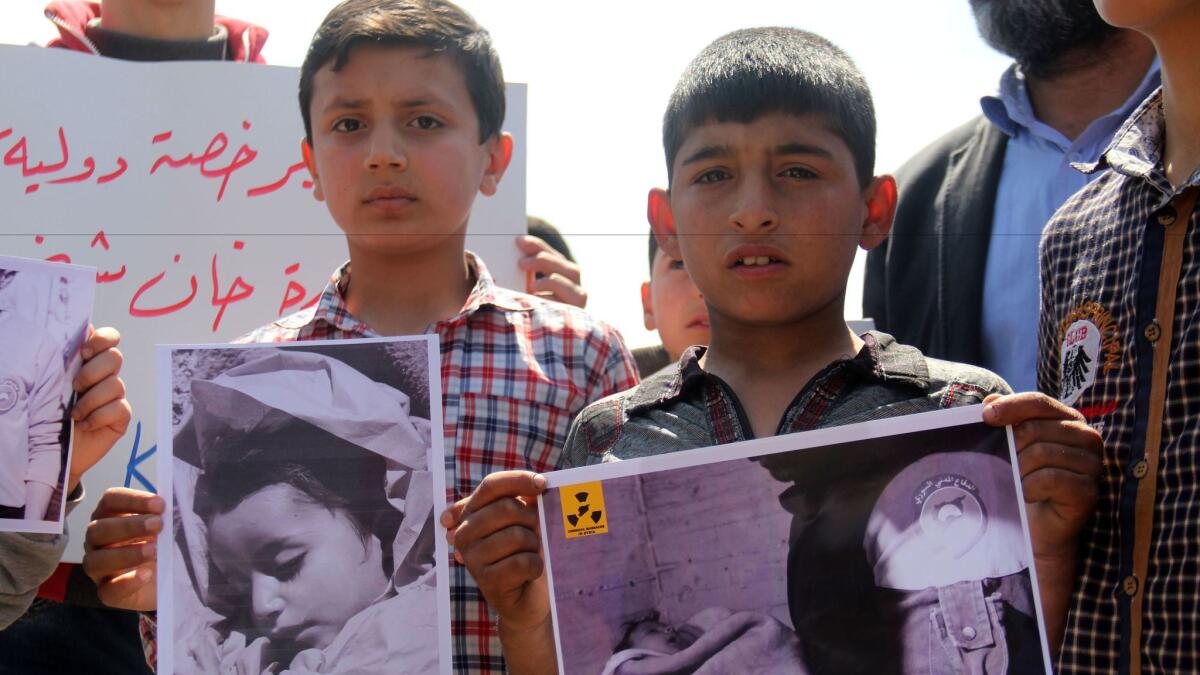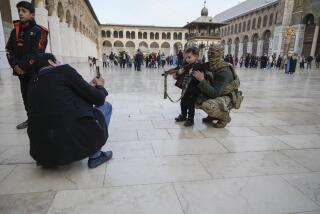Syria crisis tests Trump’s plan for a new world order

- Share via
Reporting from Washington — President Trump made an about-face in his approach to the Middle East by launching a fiery salvo of cruise missiles early Friday, and with it came relief to American allies — and many of the president’s critics at home — but its impact in Syria will ultimately depend on what Trump does next.
Attacking one airfield — at least one of the two runways were still in use Friday — hardly diminishes President Bashar Assad’s military capability. And whatever cache of poison gas or other chemical agents the Syrian government has remains intact, including one at the air base that the Pentagon deliberately didn’t target for fear of spreading a toxic cloud.
The volatile situation will quickly test the new administration’s ability to respond to international atrocities or other provocations while upholding Trump’s vow to keep the U.S. military out of prolonged ground wars around the world.
Already, administration officials are signaling the targeting of the Shayrat airfield was a one-and-done — a reassertion of American military might that will not be backed up by a more extensive plan for ousting Assad or protecting Syrian civilians from attacks that involve anything other than banned chemical weapons.
But engaging — and disengaging — in Syria is not that simple.
“If this is a one-off event, fire-and-forget retaliation against a single incident, it will prove useless,” said Frederic Hof, who was a special advisor for transition in Syria during the Obama administration. “It will prove ineffective and history will record it as such.”
Assad has any number of tools to inflict cruelty, even if the U.S. airstrike has him reconsidering the use of banned nerve agents. He could use helicopters to drop the chlorine-packed bombs his forces fashioned to inflict the same level of suffering it had before the United Nations completed its destruction of 1,200 tons of Syrian chemical agents last year.
Each new atrocity will undermine Trump’s effort to project strength and establish the red line he has declared may not be crossed, drawing Americans into a deeper conflict.
“This is the beginning, and a lot of hard things have to be done,” Sen. John McCain (R-Ariz), chairman of the Senate Armed Services Committee, told MSNBC on Friday. “This is a long, hard slog.”
Trump now faces exactly the pressures that President Obama sought to avoid when he decided against approving U.S. military strikes in Syria himself in 2013, after Congress refused to authorize them. Except now, Russian troops are in Syria, raising the stakes of an inadvertent clash with a nuclear-armed rival.
Trump acted without seeking congressional authorization. He did so swiftly and almost impulsively, driven by his revulsion at the gruesome images of the aftermath of the apparent sarin gas attacks.
It moved him to reverse course on his years-long campaign against launching exactly the airstrikes that he approved on Thursday.
The decision came after U.S. military radar and surveillance systems picked up a Syrian attack aircraft takeoff before dawn Tuesday from the Shayrat base. The craft flew 75 miles north to a rebel-held area in Khan Sheikhoun, according to the Pentagon.
U.S. officials say the aircraft dropped a bomb that quickly left many victims, including children, lifeless. Others writhed in pain, foamed at the mouth or gasped for air.
Trucks took victims to the closest clinic, where U.S. systems detected a small drone overhead about five hours later. Soon after, according to U.S. officials, a Russian-made attack jet Pentagon officials believe was flown by Russian pilots dropped a bomb on the medical facility.
At Trump’s direction, Pentagon officials drew up a menu of three attack options meant to diminish Syria’s ability to launch chemical attacks and deter Assad from using nerve agents — but not disrupt the tenuous balance of power in Syria for fear that Islamic State or other extremist groups could fill the vacuum.
Four hours after Defense Secretary James N. Mattis presented those options to Trump on Thursday afternoon at his ocean-side resort in Florida, two destroyers had launched 60 Tomahawk cruise missiles at the Shayrat airbase. They destroyed 20 Syrian aircraft, aircraft shelters, fuel storage units, ammunition supply bunkers, and advanced Russian-made radars and surface-to-air missile systems, according to U.S. officials.

Video shows U.S. destroyers Porter and Ross as they launch Tomahawk missiles into Syria. The Pentagon said 59 missiles targeted a Syrian air base.
Secretary of State Rex Tillerson conceded that at least one runway was in use Friday but he said it was not a specific target.
All but one Tomahawk, which malfunctioned and plunged into the water, hit the intended targets, U.S. officials said. The strike was not intended to wipe out Assad’s air force, but to debilitate the airfield and deliver a message that the U.S. will no longer accept chemical attacks on civilians, the officials said.
“This strike was related to the use of chemical weapons only,” Senate Majority Leader Mitch McConnell (R-Ky.) said. “I don’t interpret this as a first step toward anything else in particular other than trying to eliminate or at least to make sure … that [Assad] knows there are consequences for doing this again.”
Derek Chollet, who advised the White House and State Department on Syria during the Obama administration, doubts this will be the end. Now that military action has been taken, he said, pressure on Trump to keep Assad in check will be intense — both at home and abroad.
“Even if Assad stops using chemical weapons or we destroy whatever remaining chemical weapons he’s got, there is a slippery slope for Trump to grapple with,” said Chollet.
“The logic of intervention begins to take on a life of its own,” he added. “Those who believe this should be the beginning of a new approach will raise pressure on the administration. Allies will be thinking that this is a new era. It becomes very difficult for presidents to resist.”
The Obama administration found itself in a similar predicament in Libya in 2011, where the White House launched an air war to protect civilians from strongman Moammar Kadafi in the “Arab Spring” uprisings.
The mission morphed into regime change, as it often does, and Libya wound up in a civil war that produced a failed state where an Islamic State affiliate has taken root.
Even a narrow U.S. mission, focused on chemical weapons only, considerably expands the American role in Syria.
The U.S. military will now turn its focus to tracking down stockpiles that were thought to have been eliminated as part of an international agreement in 2013. It is unknown if Assad hid chemical agents or precursors from United Nations inspectors, or acquired them more recently.
NEWSLETTER: Get the day’s top headlines from Times Editor Davan Maharaj »
As the hunt gets underway, Trump will find himself under pressure to articulate a clear strategy for Syria. The congratulations and encouragement he received from many lawmakers and allies Friday could give way to confusion and concern about the path forward.
“As heartbreaking as Assad’s chemical weapons attack on his own people was, the crisis in Syria will not be resolved by one night of airstrikes,” House Minority Leader Nancy Pelosi (D-San Francisco) wrote Friday in a letter to House Speaker Paul D. Ryan (R-Wis.).
She called on him to bring Congress back from an 18-day recess to debate whether to authorize use of force against Syria. “The American people are owed a comprehensive strategy with clear objectives,” she wrote.
Twitter: @evanhalper
Twitter: @wjhenn
ALSO
Syrian villagers near U.S. missile strike know the sound of battle — but never as horrific as this
U.S. missile strike in Syria dashes hope of improving ties with Russia
President Trump sees push back from far-right supporters over U.S. airstrike in Syria
Editorial: Trump told Obama not to attack Syria; now he does just that
More to Read
Get the L.A. Times Politics newsletter
Deeply reported insights into legislation, politics and policy from Sacramento, Washington and beyond. In your inbox twice per week.
You may occasionally receive promotional content from the Los Angeles Times.












